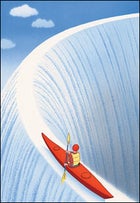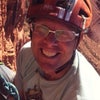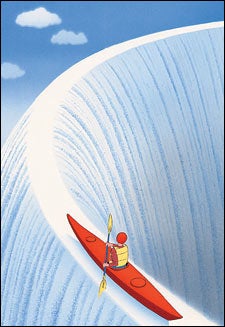WE COULD HEAR THE THUNDERING ROAR of the falls before we could see them. The apprehension spawned little leaping frogs in my gut. The falls were beckoning, and the massive White Nile—plowing along at an unbelievable 45,000 cubic feet per second—was obliging, gliding us irrevocably forward. Jane Dicey, our guide, knew our minds were haplessly entrained by the cannonade and was shouting instructions.
modern adventure

“Paddle hard. Right over the edge.”
This Class V wave train was called Total Gunga—total madness. We were aiming for a notorious hole called the G-Spot, a hydraulic so massive it could fling our raft and its eight paddlers into the African sky as easily as a kid flips a nickel into the air.
“When I say ‘Drop,'” Jane yelled, “grab the line and crouch on the floor of the raft.”
I was in the bow of the boat, leaning forward, paddling with all my strength. Jane, a 35-year-old South African who’d guided all over the world, was in the stern. She was leaning sideways, her thick blond ponytail flying out from beneath her helmet, her bronze arms steering the boat. Jane was one of those women born to be a guide: sangfroid formed into feminine flesh. The more chaos, the calmer she became.
She caught my eye and flashed a wide, here-we-go! grin.
Shooting off the falls, the bow was suspended over the drop. I snapped two futile strokes, catching only air; then we were nosediving into a cataclysm of whitewater. Jane must have yelled for us to drop, but I was too caught up in the battle. I was stabbing my paddle into the back of the beast when a ten-foot wave walloped me out of the boat and sucked me under.
Suddenly I was tumbling like a doll in a hurricane, the flashing dark water pummeling my body. I held my breath and wasn’t too scared. At one point I resurfaced and had enough sense to catch a quick breath before the river dragged me back under.
In river-guide parlance, I was being “Maytagged,” spun as if I were inside an enormous, violent washing machine.
“Don’t fight the river,” Jane had told us earlier. “There’s absolutely nothing you can do to help yourself. Be passive—thrashing will only use up oxygen. Stay calm, curl up in a ball so that you’re not twisted into a pretzel. Eventually you’ll resurface.”
Recalling her advice, I stopped struggling and tried to conserve my energy. I let myself be pulled and pushed like flotsam. It seemed to be working, but I couldn’t hold my breath forever. My lungs were in flames. The poison of fear was dripping into my mind.
At that instant I surfaced, gulping and coughing, snatched half a breath, and was dragged way back under. My helmeted head smacked something, then I was slammed against a wall of rock and dragged along its surface. Jane had said that the Nile was comparatively safe, because the water was so big the boulders were far beneath the surface. Christ, I thought, I must be 20 feet underwater!
I was out of air, and my lungs were spasming. I had been so calm before, but now I was doing exactly what you’re not supposed to do: panicking full-throttle, my head thrown up toward the faded emerald light, my arms clawing desperately toward it, my legs writhing against the down-pulling current. I would breathe water like a fish, which no longer seemed like such a bad option. At least I wouldn’t be in agony anymore, and I wouldn’t be terrified.
Then I burst through to the surface, gagging and flailing my arms. Jane merrily waved back from the raft. A minute, at most, had passed.
A CLOSE CALL makes you think. Three months later, I shattered my left wrist in a climbing accident in northern New Mexico. I fell 20 feet and hit the ground. It could easily have been much worse: I could have been paralyzed—or killed. As it is, I’m merely left with a hand that doesn’t work right. Now, after a long recuperation, and as I prepare for my first major expedition since the accident—a remote trek in Central Asia—I find myself thinking about my complicated relationship with adventure and risk.
Being held under the Nile is no picnic, and at the time I thought I was a goner. Yet the chances, in reality, were remote. I wasn’t the first person to go for what Nile guides euphemistically term a “long swim.” In fact, capsizing is so common that earlier in the day we had practiced it—intentionally flipping the boat in flatwater, going under, staying calm while our bobber-like life jackets returned us to the surface, then dog-paddling back to the raft. In the eight years that the African outfitter Adrift has been running the monstrous headwaters of the Nile in central Uganda, it’s guided 16,000 people down some of the hairiest whitewater in the world—Bujugali Falls, Easy Rider, Total Gunga, Overtime, Retrospect, Bubugo, Itanda Falls, and, finally, the Bad Place. Although thousands of clients have swum, no one has died.
This difference between what you fear might happen to you and what reasonably might—between the I’m-gonna-die! feeling I had deep inside the G-Spot and the statistical chances of actually dying—is what’s known in the canon of adventure psychology as “perceived risk versus real risk.” More than just a mind game, it’s the keystone of modern adventure.
Your perceived risk in any adventure is based largely upon two factors—anecdotal and often apocryphal horror stories (grizzly eats entire Girl Scout troop) and personal inexperience (you have no firsthand information or knowledge). Real risk, on the other hand, is based on facts. In order to move from the subjectivity of perceived risk to an understanding of real risk, you need to take the leap and participate in the adventure. The more experience you have, the more acumen; and the more acumen, the more competence, which is the prime mediator in any adventure.
Not surprisingly, risk—both perceived and real—is inversely proportional to competence. As your skill in any sport increases, your perception—or, more likely, misperception—of the dangers decreases and, naturally, so does your fear. Once you learn how to roll your kayak, flipping over no longer freaks you out; when you can finally link telemark turns, steep slopes become inviting instead of terrifying; learning when to hunker down in a raft reduces your chances of a long swim. With this hard-won competence, real risk also decreases. If you know how to hand-jam, you’re not likely to fall from the overhang; if you know how to bunny-hop, you probably won’t endo over the log.
The capability to accurately assess these two factors—your own competence and the real risk—is crucial for both safety and success. Disaster can strike when you overestimate your ability and underestimate the real risk. Conversely, undervaluing your skills and overestimating the risk—thus amplifying irrational fear—can be so inhibiting that chances are good you won’t give it a try at all, or you’ll fail in your attempt, confirming what wasn’t true in the first place. Between either extreme lies the sweet spot: that world-opening state where you have both an accurate understanding of your own abilities and a clear-eyed sense of the true risks.
This paradigm of risk is a recent development. For more than 70,000 years, humans lived outside, where life-and-death threats were a constant reality. To survive as a species, we had to adapt to adventure—physically, psychologically, and spiritually. Through much of the past millennium, adventure was synonymous with exploration or war, which meant you might not come back alive. In 1519, Ferdinand Magellan, bent on becoming the first man to circumnavigate the world, sailed from Spain with five ships and 234 men; three years later, only one ship and 18 men listed back into port—Magellan was not one of them. On his 1778 voyage, Captain Cook became the first European to set foot in Hawaii; he returned there a year later and was promptly killed. A month after becoming the first European to reach Timbuktu, in 1826, Alexander Gordon Laing was beheaded outside the fabled city.
Today, exploration and adventure have largely diverged in both meaning and substance. Apart from the deepest parts of some oceans, most of the world is mapped and explored, at least on the macro scale. A small core of adventurers are still attempting bold explorations—first ascents and descents, virgin BASE jumps, and mammoth waves—where the risks are truly unknown and death is a real possibility. But just one step back from the mortal edge lies the expansive kingdom of modern adventure, where the chances of dying diminish dramatically but the thrill of the challenge thrives. Genetically programmed for risk but now living in warm houses and paying fat health-insurance premiums, we still crave adventure—we just don’t want to die doing it.
NO WONDER, THEN, that the optimal adventure experience for many enthusiasts is one in which the perceived risk is high but the actual risk is acceptably low. Running rapids is a good example. “People look at big whitewater, and their perception is that it’s very dangerous,” says Pamela Dillon, executive director of the American Canoe Association. “But the stats tell a different tale. In sheer numbers—including canoeists, kayakers, and rafters—the most common way someone dies boating is in a canoe, on flatwater, with no PFD [personal flotation device], drinking alcohol.
“Fifty percent of people who die in canoes and kayaks are out fishing,” Dillon continues. “They’re not tuned in to the skills and information they need to participate safely.”
Charlie Walbridge, longtime board member of the American Whitewater Safety Committee, has been tracking whitewater accidents for three decades. Like Dillon, he believes a failure to take sensible precautions is responsible for most deaths.
“The number-one reason people get killed on whitewater is because they’re not wearing a life jacket,” explains Walbridge, who began boating in the 1960s, when everyone made their own fiberglass kayaks and sewed their own spray skirts.
“Today the gear is much better and much safer, and there’s so much instruction available that there’s really no excuse not to do the basic things right. What’s wonderful is that, unless you’re doing an exploratory expedition, you get to choose your level of challenge. Almost every adventure sport can now be participated in at a level that’s just plain fun.”
I’VE BEEN CLIMBING FOR 30 years—squeaking through first ascents on snow and rock from Utah to Greenland, Tibet to Bolivia—and this busted wrist is my first serious injury. Which isn’t to say that there haven’t been times when luck alone saved my ass. Still, the sport of climbing, like river running, has evolved dramatically in the past half-century.
In 1966, American alpinist John Harlin II was making the first ascent of the direct route of the Eiger’s north face when the rope snapped and he plummeted 3,750 feet. It was a horrific death that became the subject of numerous articles and inspired the 1975 Clint Eastwood thriller The Eiger Sanction.
But four decades later, modern climbing ropes, unless they’re corroded with acid or cut with a knife or sharp rock, simply don’t break (although they do wear out and need to be replaced). Equipment failure in rock climbing and mountaineering is extraordinarily rare. According to the American Alpine Club’s Accidents in North America 2004, of the 5,840 reported accidents and 1,304 reported deaths from climbing in the U.S. between 1951 and 2003, a mere 13 (about one-fifth of 1 percent) were attributed to malfunctioning gear.
Still, I always instinctively check my ropes, my harness, my knots, my partner’s knots, my equipment, the anchors. Never forget: Our hardwired fear of death is an extremely healthy and useful survival trait. It’s what makes us cautious, careful, and thorough. On the other hand, too much fear is paralyzing. Finding your own balance—between legitimate concern and irrational worry—is part of the path to adventure.
Hitting the ground has also made me think about the fear of falling. It’s one of the few innate human fears, an evolutionary adaptation passed down in our genes from the time we lived in trees. The gush of adrenaline when you’re clinging to rock, toes trying to smear onto a dime-thin ripple and sweaty fingers losing their grip, is precisely what makes climbing so alluring. It creates a high perceived risk while the actual risk is typically pretty low—as long as you and your partner are following basic safety procedures. This, of course, is a critical caveat. Climbing is one of the few sports in which you literally put your life in someone else’s hands. Too many accidents are still occurring, often because climbers are untrained or inattentive.
Mountaineering, on the other hand, carries with it significantly higher, very real risk. This is usually attributed to objective dangers—unpredictable acts of God, such as avalanches, icefalls, rockfall, and horrid weather.
The last conversation I had with alpinist Alex Lowe, in August 1999 in Salt Lake City over a tumbler of single-malt, was about how many chin-ups a climber needed to do to stay fit for the mountains. We agreed it was between 100 and 200 per day. But in the end it was irrelevant. Several months later, Alex died in an avalanche on Shishapangma, a 26,289-foot peak in southern Tibet. (I’d climbed that same peak, fortuitously without incident, in 1984.)
So objective dangers are real, but are they really common?
Wyoming climbing rangers George Montopoli and Renny Jackson, as well as statistician Ken Gerow, analyzed all 90 backcountry deaths in Grand Teton National Park between 1950 and 1996. Only 3 percent were caused by rock- or icefall, 1 percent by lightning, 9 percent by avalanches. A whopping 73 percent were due to slips or falls on snow or rock. Half the people killed rock-climbing in the park were unroped.
“The reality is that the biggest producer of accidents here is unroped slips on snow,” says Jackson, 52, co-author of A Climber’s Guide to the Teton Range. “With an ice ax and sturdy boots, if you have the ability and skill to execute an instantaneous self-arrest, you’re going to be fine. You can go a lot of places, climb a lot of peaks. Without this skill, you run a risk of being one of the statistics.”
Jackson maintains that even objective hazards are not absolute and can be minimized through behavior and knowledge—taking an avalanche course, a first-aid class, a seminar in weather, and then applying what you’ve learned in the mountains.
“Ultimately, the perceived risks are not what normally kill people,” he says. “What kills people is pilot error: poor judgment and lack of basic skills.”
DURING MY FINAL hand exam before leaving for Asia, Colorado surgeon Ken Duncan, an extreme climber and kayaker, told me my wrist might not ever heal 100 percent, but I could “go for it now.” No restrictions.
Just in time. My partners and I plan to attempt three unclimbed 20,000-foot peaks. We’ve been told that the most serious risks we’ll face are avalanches, land mines, Russian helicopters, shoddy buses, and rabid dogs. On the bright side, at least I won’t have to worry about bears.
I’ve had close encounters with grizzlies in Alaska, Canada, and Wyoming, and they always scare the hell out of me. For good reason. I’m slower than every other prey species in the woods, from deer to ducks, and would make a fine meal. I’ll undoubtedly have future opportunities to be reincarnated as a large pile of steaming bear scat, but what are the chances, really?
In a word, slim.
Between 1980 and 1994, Yellowstone National Park recorded more than 600,000 backcountry overnights and hundreds of thousands of day hikes. In this period there were 21 grizzly-related injuries—fewer than three for every 100,000 visits. Since 1895, more than 130 million people have visited Yellowstone; five have been killed by grizzlies, the last one in 1986. Grizzlies do kill people now and then, but—as it turns out—they are pathetically ineffective com-pared with more contemporary murderers, like cars, cholesterol, and cigarettes.
And what are the risks of being mauled by other backcountry predators?
While elk-hunting this past year in the Beartooths, I came upon mountain lion tracks in the snow. They were so large I thought at first they were bear tracks, and I spent the rest of the day anxiously glassing the cliffs above. I needn’t have bothered. Since 1890, fewer than 100 people have been attacked by a mountain lion in the U.S., and 18 of them died. In short, the chances of being killed by a mountain lion while out hiking, biking, climbing, camping—you name it—are statistically insignificant.
So, out in the wilds, what are we worrying about? The wrong stuff.
Not that we shouldn’t acknowledge, even relish, perceived risks. What would climbing be without the threat of falling? What would the wilderness be without lions and tigers and bears? What would rivers be without whitewater?
So go ahead, revel in your fears. Just as long as you understand and are prepared for the real risks. Just as long as you don’t forget that, in the end, it’s not lightning or rapids, avalanches or equipment, rockslides or icefalls that are going to get you. It’s you. On any adventure of any kind, you are the greatest risk to yourself.


